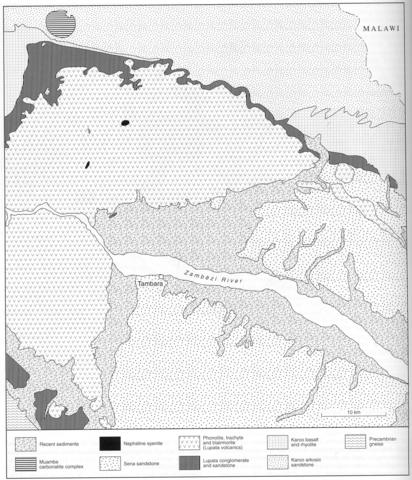stripes
A syncline plunging to the southeast, which is traversed by the Zambezi River, contains a thick succession of upper Karoo (Stormberg) basalts and rhyolites which are overlain unconformably by alkaline lavas - the Lupata volcanics. The complete succession is exposed along the Lupata Gorge (Dixey and Smith, 1929; Flores, 1964), which is about 70 km down stream from Tete. The Karoo basalts are tholeiitic, about 600 m thick and overlie arkosic sandstones. They are succeeded unconformably by 80-100 m of arkosic sandstones and then by 80 m of rhyolites, which are often columnar, with some tuffs at the top of the succession. There is then an angular unconformity above which conglomeratic sandstones, tuffaceous sandstones and possible tuffs are about 150 m thick. The overlying alkaline lavas comprise some 300 m of phonolite, trachyte and rare analcime-phyric phonolite (blairmorite), and these in turn are overlain by the conglomeratic Sena sandstone. There are a few small intrusions of nepheline syenite cutting the lavas the largest of which, with a diameter of about 1 km, forms Mount Nhamauro. Afonso (1975) gives the sequence of alkaline rocks at one locality as, from bottom to top, olivine trachyte (kenyte), porphyritic trachyte, agglomerate, aegirine-augite trachyte, analcime phonolite (blairmorite) and at another place as lamprophyric trachyte, agglomerate, analcime and nepheline trachyte, agglomerate, nepheline phonolite. On the 1:250,000 geological map (Afonso, 1975) trachytes are shown as by far the most extensive type but phonolites and trachytes are not distinguished in the petrography of Afonso (1975), while Dixey and Smith (1929) only recognise various types of phonolite. The alkaline lavas may form individual flows 70-80 m thick but whether they erupted from fissures or central vents is not clear, though Dixey and Smith (1929) suggest that Ncheni peak may represent the flank of a vent. The phonolites may be porphyritic or aphanitic. Phenocrysts are alkali feldspar, nepheline, aegirine-augite and magnetite set in a fine-grained groundmass of very small feldspar and nepheline crystals in which patches of aenigmatite, aegirine or aegirine-augite and a blue amphibole form spongy patches. The trachytes, described as kenytes by Teale and Smith (1923) and Dixey and Smith (1929), contain phenocrysts of alkali feldspar and nepheline and microphenocrysts of aegirine-augite and magnetite in a groundmass of feldspar and nepheline laths and patches of aenigmatite, katophorite, aegirine-augite and aegirine. Some of these kenytes contain analcime phenocrysts and a little biotite and such rocks grade into blairmorites. These unusual rocks occur on both sides of the Zambezi (Dixey and Smith, 1929) and are distinguished by the presence of abundant analcime phenocrysts up to 2 cm in diameter, with narrow rims of alteration, which may constitute a quarter of the rock (Woolley and Symes, 1976); altered phenocrysts of nepheline are less abundant. The groundmass comprises plates of K-feldspar, nepheline, aegirine, an opaque phase and apatite. Two specimens of nepheline syenite from intrusions within the lavas north of the Zambezi are described by Dixey et al. (1937, Appendix E) as foyaites. One consists of alkali feldspar, nepheline, aegirine-augite fringed by aegirine and biotite and occasional sodalite as euhedral crystals within nepheline. A microfoyaite also contains prisms of aenigmatite and katophorite and some eudialyte. Six analyses of the alkaline volcanic rocks will be found in Coelho (1959), 13 in Afonso (1975) and five, including a foyaite, in Woolley and Garson (1970). Woolley and Symes (1976) give analyses of feldspar, nepheline and analcime from blairmorites and kenytes.
AFONSO, R.S. 1975. Contribuição para o conhecimento da geologia da área de Tambara-Dóa (Folha SUL-E-36/E, Grau Quadrado 1634). Boletim dos Serviços de Geologia e Minas, Lourenco Marques, 38: 1-153.DIXEY, F. and SMITH, W.C. 1929. The rocks of the Lupata Gorge and the north side of the Lower Zambezi. Geological Magazine, 66: 241-59.DIXEY, F., SMITH, W.C. and BISSET, C.B. 1937. The Chilwa Series of southern Nyasaland. Bulletin, Nyasaland Geological Survey, 5: 1-82. (reprinted 1955)Flores, 1964; MINERAL INVENTORY PROJECT, FINAL REPORT. 1984. Hunting Geology and Geophysics Limited. For Governo da Republica Popular de Mocambique. Ministerio dos Recursos Minerais Direccao National de Geologia. 329 pp.TEALE, E.O. and SMITH, W.C. 1923. Nepheline-bearing lavas and intrusive rocks from south of the Zambezi River, with a note on an outcrop of Karroo lavas in the Buzi Valley, Portuguese East Africa. Geological Magazine, 60: 226-37.WOOLLEY, A.R. and GARSON, M.S. 1970. Petrochemical and tectonic relationship of the Malawi carbonatite-alkaline province and the Lupata-Lebombo volcanics. In T.N. Clifford and I.G. Gass (eds), African Magmatism and Tectonics. 237-62. Oliver & Boyd, Edinburgh.WOOLLEY, A.R. and SYMES, R.F. 1976. The analcime-phyric phonolites (blairmorites) and associated analcime kenytes of the Lupata Gorge, Mocambique. Lithos, 9: 9-15.

